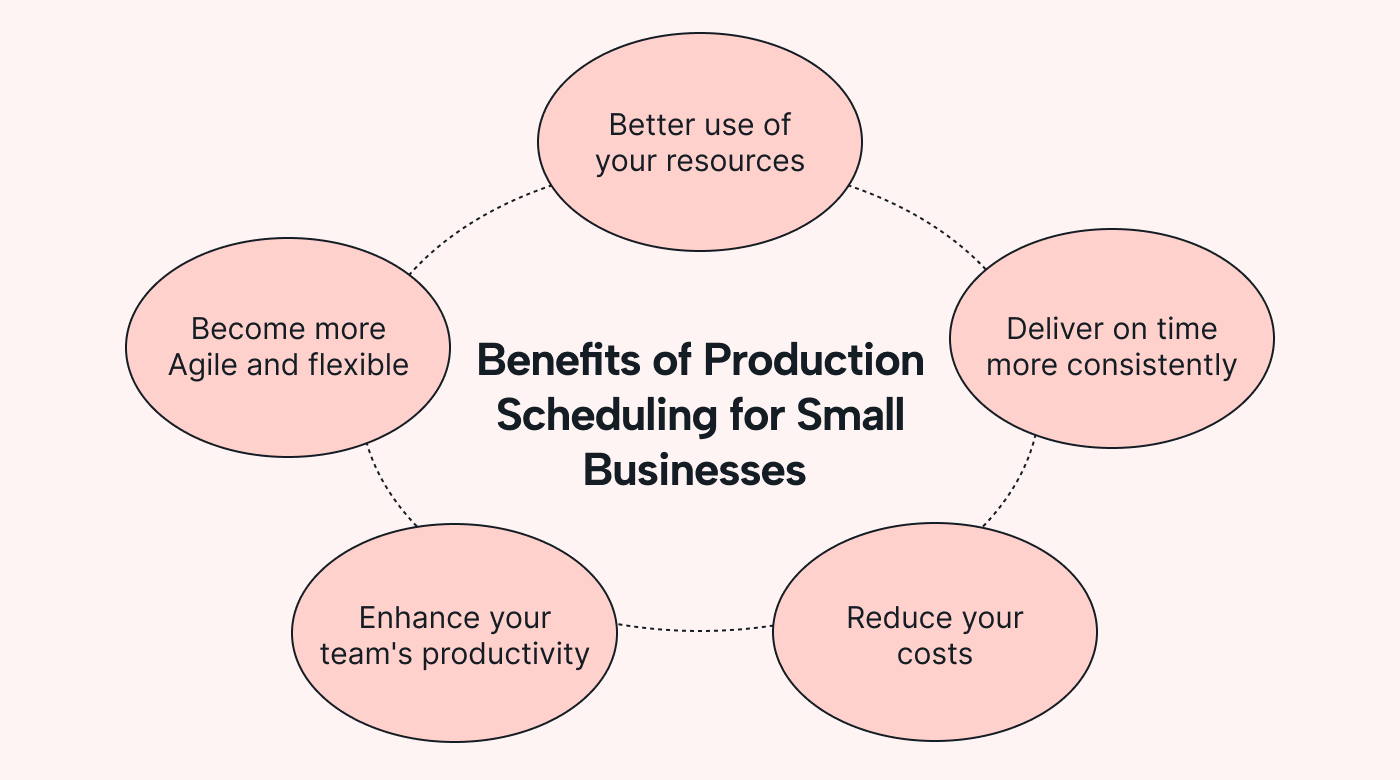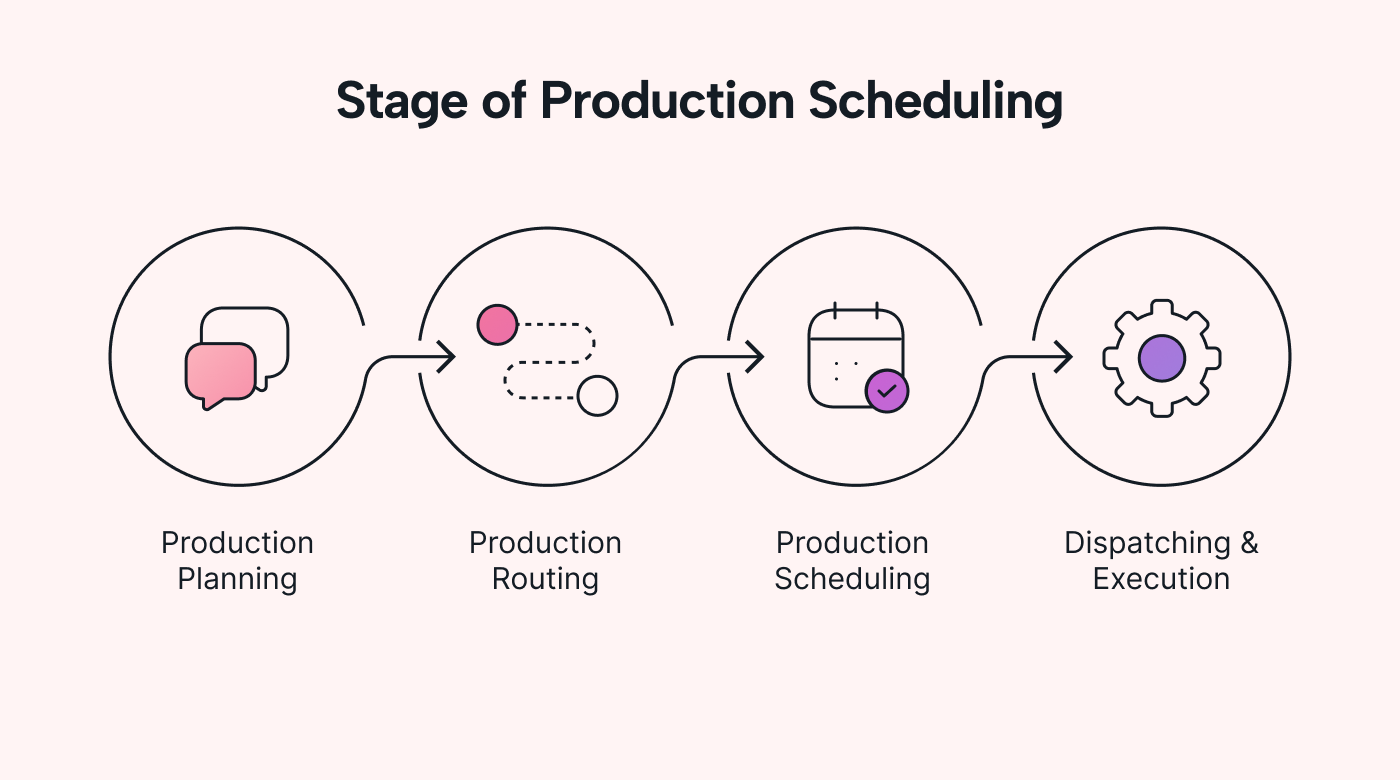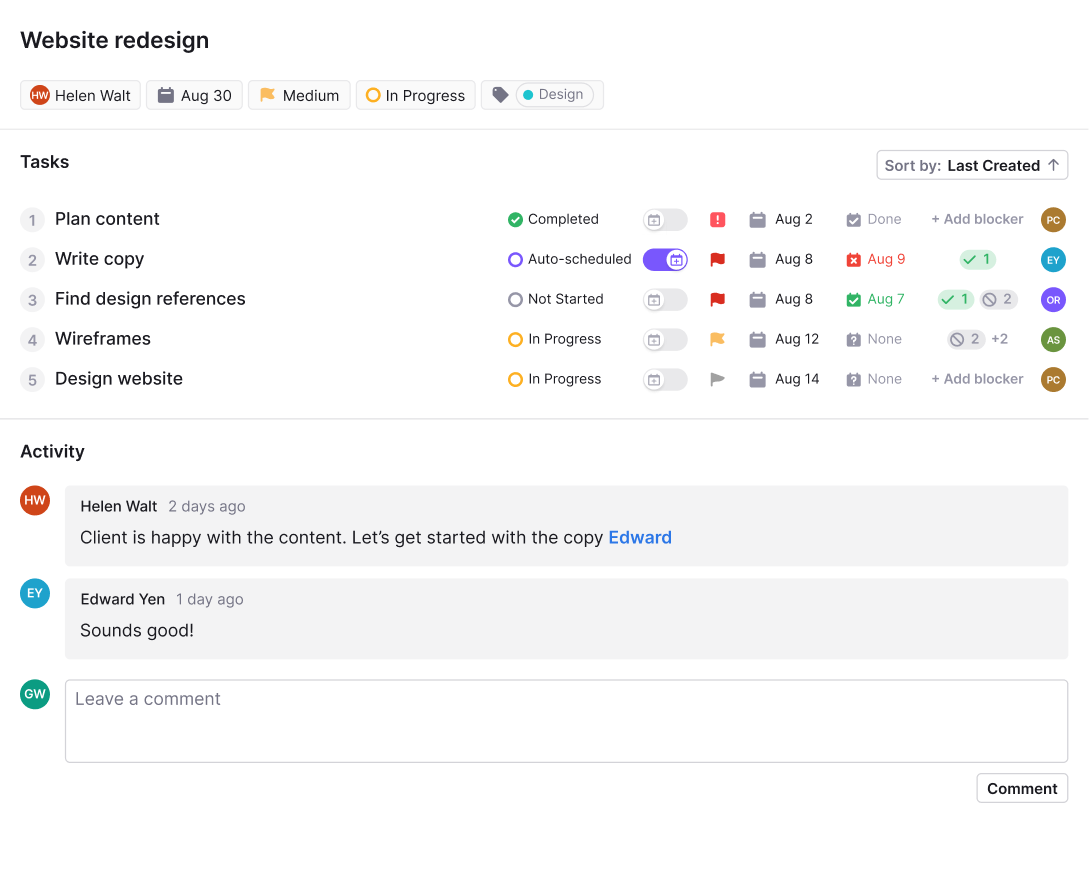Tired of always being one step behind? Your business is making money. The projects keep rolling in. But, you know that you could do even more if things were a bit more organized.
Despite your thinking, more communication with your team isn't the answer.
In fact, 58% of Americans would rather see their doctor than endure a status meeting. It’s time to find new ways to keep teams on track and improve your overall production efficiency simultaneously.
Optimizing production with some simple but effective changes can revolutionize the way you do business without the need for more meetings.
In this article, we’ll explore production scheduling, its benefits, and how to apply it in your business.
What is production scheduling?
Production scheduling is often associated with raw materials, assembly lines, and a manufacturing process, but it can be helpful for all kinds of businesses. No matter what industry or department you’re in, production scheduling can help you remove waste in your production processes and increase your production capacity.
But what does it look like in practice?
Let's take a building company as an example. Production scheduling helps with the timely delivery of projects by mapping all tasks and their allocated resources on a manufacturing schedule. It makes it easy for builders to streamline their operations because all homes are built to set timelines with staff, materials, and other variables accounted for.
In a marketing agency, however, production scheduling would look different. Instead, you'd focus on sequencing project tasks and their dependencies. This creates the most effective order to deliver activities like copywriting, graphic design, UX, and development. It also helps to consistently get work to customers on time. This helps the agency owner consider resource availability and schedule the right team members across many projects.
What’s the difference between a production plan and a production schedule?
In the production world, it's important to understand the difference between a production plan and a production schedule. Both are essential to delivering work (and they work in tandem).
Production planning
This is like the big-picture planning phase for your entire project. It's where you figure out what needs to happen from start to finish. During planning, you don't just focus on the schedule (timeline). You also need to consider what raw materials are needed, how many people are required to do the job, and how you will get those supplies and staff scheduled at the appropriate times to finish on time.
Production scheduling
The production scheduling process is where you set the specific timeline for when each part of the project or production will happen. It’s like plotting out the route for a road trip, ensuring you know when and where you’ll stop. You might use the critical path method (CPM) on a PERT chart to help track these checkpoints. These will help you visually map which tasks depend on others and in what order they should happen to give you accurate delivery dates.
Both production planning and production scheduling are important to making informed decisions. Getting them right can be the key to having a smooth production process.
What are the benefits of production scheduling for small businesses?
While production scheduling might have roots in a production facility, it benefits any type of business.
Better enterprise resource planning
We know what you're up against. You're rushing against the clock, and have limited resources (resource constraints). Production scheduling helps you make the most of what you have. By organizing and prioritizing tasks based on their importance, how they depend on each other, material requirements, and the availability of resources, you improve the utilization of resources, minimize waste, and boost profitability.
Better production timelines
When you schedule your work effectively, you'll improve resource utilization, cut idle time, and are more likely to deliver your projects or products in a planned time frame. Meeting or beating deadlines (and customer expectations) leads to better customer satisfaction.
Reduce costs
Small businesses need to watch their bottom line closely. Effective scheduling can help you identify areas where you can cut costs, like reducing overtime, optimizing inventory levels, and streamlining or automating time-consuming processes.
 |
Enhance productivity
When employees know what tasks to do and when to do them, it reduces confusion and downtime. Pair this with project management software where you can centralize your team's schedules and use real-time data to make data-driven decisions, and you'll see improvement immediately.
Increase agility
Small businesses often need to adapt quickly to changes in customer demand or unexpected disruptions. Production scheduling allows you to adjust your production process more easily. Whether accommodating rush orders or improving resource allocation to meet market changes, good scheduling leaves room for flexibility.
The four stages of production scheduling and how they apply to you
Let’s take a look at the four stages of production scheduling and how they can be applied to three different businesses: an accounting firm, a dental office, and a marketing agency
1. Production planning
Just like project planning in traditional project management, the production planning process is all about getting organized before work even begins.
In a marketing agency, this might be the planning of a content marketing campaign. The plan would be based on the number of blog posts, social media posts, and email newsletters to be produced in a given month and the resources available. Deciding this wouldn't make sense when the copywriter is already working.
2. Production routing
Production routing defines the sequence of steps and activities that a product or service goes through to be produced. All tasks and their dependencies are ordered sequentially and then scheduled on the timeline.
While this applies to complex projects, it works for smaller processes like an accounting firm preparing clients' tax returns. Production routing for an accounting firm might include the following steps that must be completed in this given order:
- Receive client financial documents
- Assign the client to a specific accountant based on the complexity of the return
- Perform a preliminary review of the documents to make sure everything required has been provided
- Complete the tax return to internal guidelines
- Conduct a quality review where a second staff member reviews the work
- Deliver to the client and get their approval and sign off to deliver it
- Submit the return to tax authorities
- Archive client records for the mandated length of time required by industry bodies.
 |
3. Production scheduling
In the production scheduling stage, you outline when and how each production task should be executed.
In a dental office, this could be a color-coded and prioritized staff calendar that has patient appointments scheduled throughout the day, optimizing the treatment rooms and staff (hygienists, receptionists, and dentists) available.
4. Production execution
Simply put, this is where production happens. During this stage, you'll want to monitor the work, track progress against the plan, and avoid or mitigate production delays. In our examples, this could look like this:
Accounting firm:
- Execution: Staff members prepare tax returns according to the schedule, ensuring client documents (the finished product) are processed accurately and on time.
- Monitoring and control: Internal auditing quality control measures (reviewing the progress and accuracy of tax return processing) could involve tracking how many returns are completed in a day and addressing potential bottlenecks or quality control problems.
Dental office:
- Execution: The work follows the appointment schedule, maintaining patient flow as planned (and no long wait times for customers).
- Monitoring and control: Patient wait times and satisfaction are tracked. This will help to adjust the schedule to reduce problems (and customer frustration) over time.
Marketing agency:
- Execution: Content creators write blog posts and design graphics as scheduled, and the social media team posts their updates on the website.
- Monitoring and control: Content metrics such as engagement (likes and comments) and conversion (clicking through to the target webpage) are tracked so they can be optimized over time.
Sound like a lot of (extra) work? Not really. You're probably already doing these in your business. You just haven't formalized them. Plus, there's good news. You don't need to do all the work of production scheduling.
Take a load off with a production software solution
Don’t let the manual work of production scheduling weigh you down. Here’s what you should be looking for in production scheduling software:
AI-driven scheduling tools
- Calendars that automatically keep projects (and staff) on track.
- An AI-driven Project Manager that weighs workloads, prioritizes your tasks, adds tasks to schedules, and sends deadline alerts to ensure production schedules stay on track.
 |
Easy integrations with your favorite tools
- One-click Zoom, Google Meet, or Microsoft Teams meeting launch.
- Seamless integration of personal and work schedules.
Simple customization to suit your unique needs
- Customizable prioritization of daily tasks, meetings, and personal events.
- Individual and team-wide calendar views, with personal items hidden.
Effective production scheduling takes time. But it doesn’t have to be your time. Take advantage of AI to get the best of project management and scheduling in one place.
Motion: Your new AI-driven production scheduling assistant
If you aren’t one of those people blessed with the deep desire to organize, scheduling complex projects with lots of tiny tasks might be your worst nightmare.
This is where production scheduling software is your best friend.
Think of Motion as your scheduling AI assistant. It manages staff schedules, automates recurring tasks, and even auto-updates the team calendar as changes occur in staff availability and project milestones.
Say goodbye to the mental load of project scheduling and say hello to your new best production friend.





